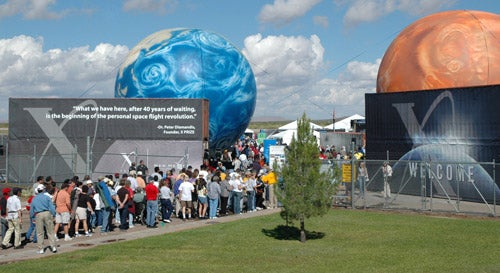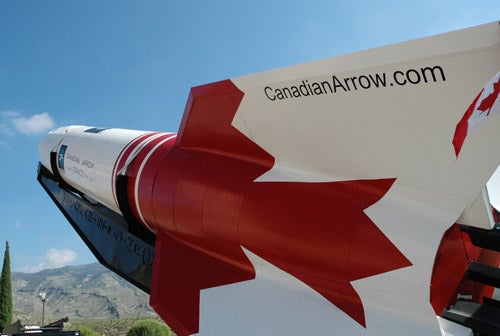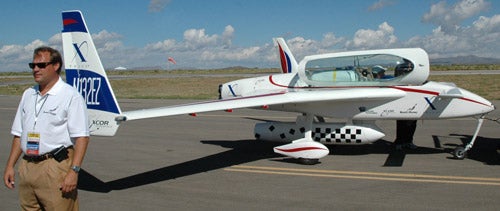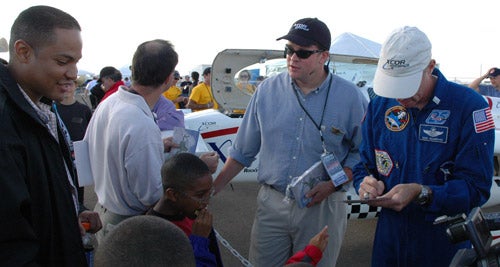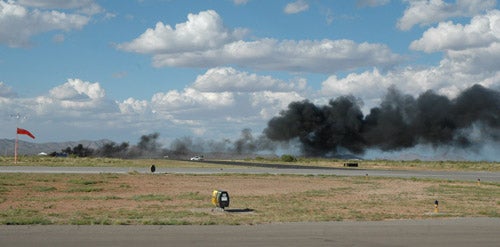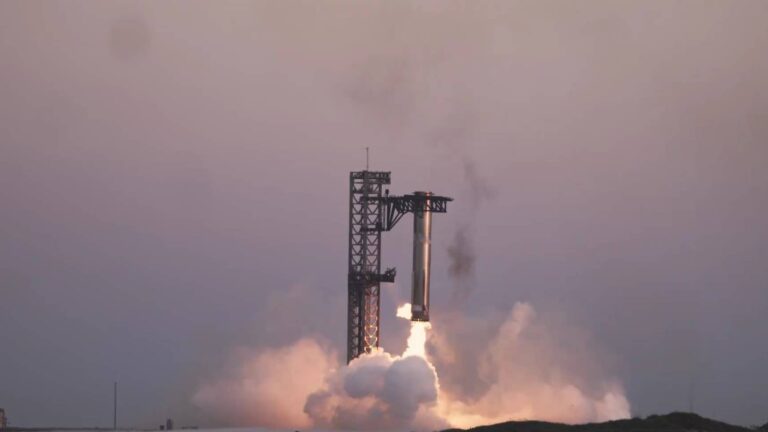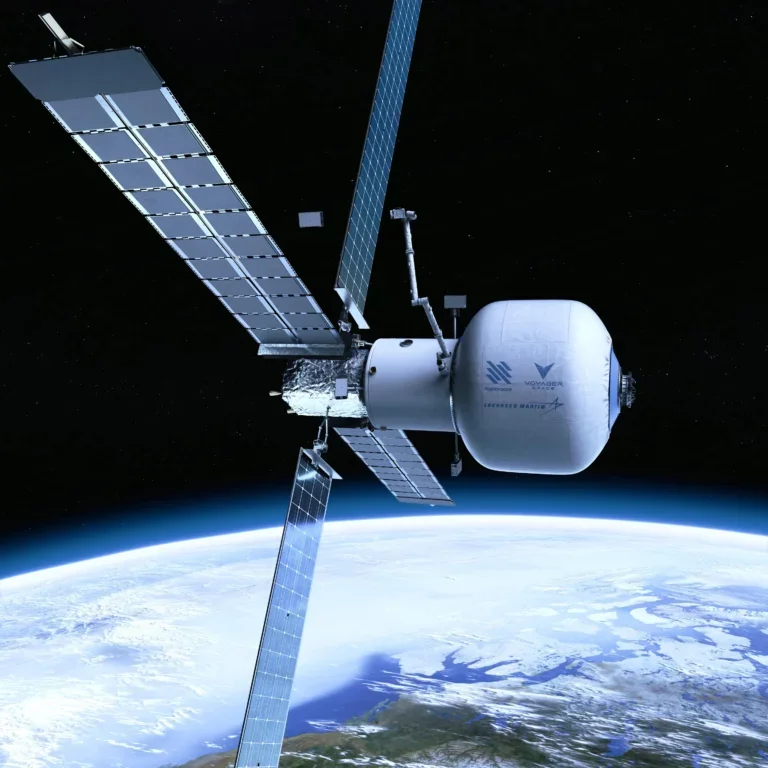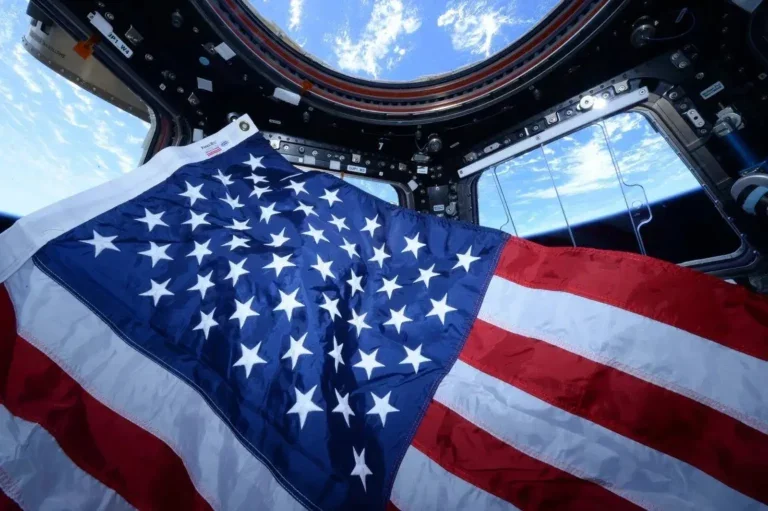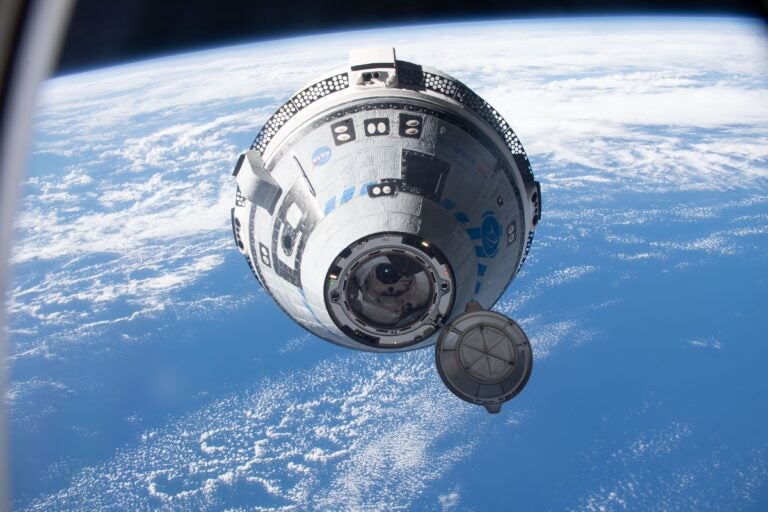The X Prize Foundation and State of New Mexico held the first annual X Prize Cup and Personal Spaceflight Expo last week in Las Cruces.
During the weeklong festivities, space experts from around the world spoke at New Mexico State University regarding commercial space exploration. And more than 1,000 local students gathered at the New Mexico Museum for Space History in Alamogordo for activities related to space, astronomy, and rocketry.
The main event, held last Sunday, was the official “Countdown to the X Prize Cup” at the Las Cruces airport. “Come on in!” cheered Peter Diamandis, chairman of the X Prize Foundation, as hundreds of spectators waited behind a red ribbon he and others were ready to cut.
The new grounds displayed experimental rockets, spaceships, and other technologies from companies that competed in the $10 million X Prize last year. A concert-style stage with blaring speakers and video screens played prerecorded and live video feeds for the audience.
“What you’re seeing here today is a taste of what X Prize Cup will be in the future. Our vision is to have an event that will attract hundreds of thousands of people,” said Diamandis. It will be “an event people plan their vacations around,” he added.
Sunday’s Expo was threatened the night before by rain, and some of the launches were scrubbed due to high winds. XCOR’s EZ Rocket plane, piloted by former shuttle astronaut Rick Searfoss, was the show’s main event, roaring past the crowd twice that day. The EZ Rocket is a precursor to the Mark-1 X Racer currently under development for the new Rocket Racing league. Test flights are scheduled for spring 2006.
Another company that demonstrated rocket power was Armadillo Aerospace out of Mesquite, Texas. “There’s no reason why suborbital flight can’t get down to the $10,000 ticket-price range, but that’s only going to happen when launching rockets is not an event. It’s got to be like riding the elevator, ‘just get in, fly up, get down, get off,'” said John Carmack, Armadillo’s founder.
Armadillo managed to get one of its three planned launches off the ground. The vertical-takeoff vehicle hovered about 25’ (8 meters) above the ground for a few seconds as planned — then landed and, ultimately, tipped over, damaging an internal fuel hose.
Starchaser Industries was there also, with its full-size three-man capsule mock-up and other exhibits. The team attempted to test fire its Churchill Mk2 rocket engine. However, the engine blew up in the distant desert before the crowd.
Steve Bennett, Starchaser’s CEO, said this was the ninth time firing this particular engine, “So, eventually, it was going to go ‘pop.’ In the world of rocket science, you can learn a lot from an anomaly like this,” he responded.
One of the most impressive showcases was a rocket named Canadian Arrow by PlanetSpace. This group didn’t have any live demonstrations, but its display was the most prominent and popular on the grounds. PlanetSpace has completed a number of successful engine tests, with the most recent powering out 50,000 pounds of thrust. The rocket is a 54-foot-long, two-stage, three-person suborbital rocket modeled after the World War II V-2 rocket. The company plans to make space flight available to the public within 2 years.
UP Aerospace announced it’s conducting the first space launch out of the Las Cruces Spaceport March 27, 2006, in conjunction with X Prize. Spectators will watch a live video from the rocket as it travels into space. They will also bring the rocket back to the X Prize grounds for the audience to observe up close and photograph.
UP Aerospace plans to provide low-cost space access to universities and colleges. “They can develop experiments, test them, fly them into space, and get their data back and do some real science,” Eric Knight, UP Aerospace’s CEO, told reporters.
Program manager for NASA’s centennial challenge Brant Sponberg made another announcement only moments before the new grounds were opened to the public. Diamandis and Sponberg announced two new prize competitions in the arena of suborbital rocket flight:
-
- Sub-Orbital Payload Challenge: a certain size payload must reach a certain altitude, higher than 60 miles (100 kilometers)
- Sub-Orbital Lunar Landing Analog Challenge: a reusable suborbital rocket that takes off and lands vertically and reaches certain speed, demonstrating capabilities necessary to land and launch from the Moon
Both prizes are considerably larger than $250,000, and details will be released in the next few weeks.
“It’s our goal that these and other prizes will create each here in New Mexico a multimillion-dollar cash purse that will attract teams from around the world,” said Diamandis.
In coming years, New Mexico will develop a Southwest Regional Spaceport near Las Cruces, supported by $9 million in state funds.
“Our goal is to provide a home for this industry,” said Rick Homans, state secretary of economic development in New Mexico. “10 years, 20 years, 30 years from now, there will be hundreds, if not thousands, of people employed in this industry,” he added.
As more companies progress in endeavors toward commercial space flight, the annual X Prize Cup will offer more to visitors. As host Bob Picardo of Star Trek Voyager said about this year’s event: “We are going to see dreamers testing their dreams.”

